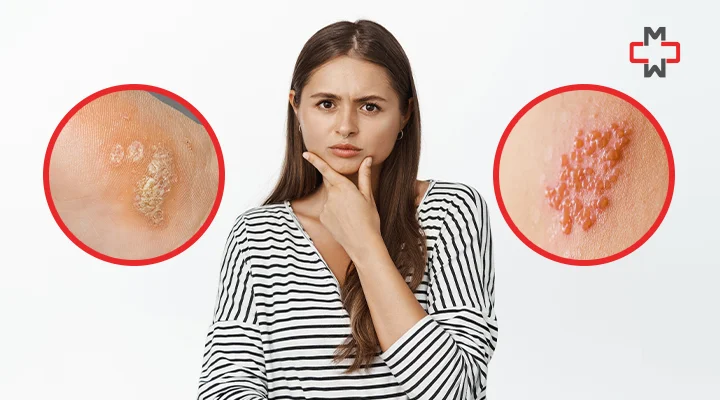What are HPV and Herpes?
HPV and herpes are viral infections that can be transmitted through sexual or skin-to-skin contact. HPV comprises a group of over 200 viruses, some of which can cause warts, while others are linked to various cancers. On the other hand, herpes, caused by the Herpes simplex virus, manifests as either oral herpes (cold sores) or genital herpes.
Difference Between HPV and Herpes
While both HPV and herpes are sexually transmitted infections (STIs), they differ significantly in their causative agents, symptoms, and associated health risks. HPV primarily leads to genital warts and is a major contributor to cervical cancer, while herpes manifests as painful blisters and sores, with HSV-2 primarily affecting the genital region.
How Common Is HPV and Herpes?
HPV is incredibly common, with nearly 80 million Americans currently infected and around 14 million new cases diagnosed each year. Herpes, too, is widespread, affecting about one in every six people aged 14 to 49 years.
What Causes HPV and Herpes?
– Causes of HPV:
- Sexual Contact: HPV spreads primarily through sexual contact. And even skin-to-skin contact with an infected person can transmit the virus.
- Multiple Sexual Partners: Having multiple sexual partners increases the risk of HPV infection due to increased exposure to the virus.
- Unprotected Sex: Not using condoms can facilitate HPV transmission from an infected partner.
- Weakened Immune System: Conditions like HIV/AIDS, organ transplantation, or immunosuppressive medications can increase the risk of HPV infection.
- Genital Warts: Certain HPV strains causing genital warts can spread through direct skin-to-skin contact, even without visible warts.
- Vertical Transmission: Rarely, HPV can pass from mother to baby during childbirth, leading to respiratory papillomatosis in infants.
– Causes of Herpes:
- HSV Transmission: Herpes is primarily caused by HSV-1 and HSV-2, transmitted through direct contact with infected mucous membranes or skin lesions.
- Sexual Contact: Genital herpes spreads through sexual activity even without visible symptoms.
- Skin-to-Skin Contact: Herpes can transmit through skin-to-skin contact with an infected area, such as kissing or touching active lesions.
- Vertical Transmission: Pregnant women with genital herpes can pass the virus to their newborn during childbirth, leading to neonatal herpes.
- Asymptomatic Shedding: Even without symptoms, infected individuals can shed the virus and infect others, more common with HSV-2.
- Weakened Immune System: Conditions like HIV/AIDS or certain medications can increase the risk of herpes infection and worsen symptoms.
Symptoms of HPV and Herpes
– Symptoms of HPV:
- Genital Warts: HPV infection often manifests as genital warts, appearing as small, flesh-colored bumps or clusters in the genital or anal area.
- Abnormal Pap Smear: HPV can cause abnormal changes in cervical cells detectable through a Pap smear, potentially indicating high-risk strains associated with cervical cancer.
- Cervical Cell Changes: Persistent HPV infection, particularly with high-risk strains, can lead to cervical dysplasia or intraepithelial neoplasia (CIN), increasing the risk of cervical cancer.
- HPV-Related Cancers: Besides cervical cancer, certain HPV strains can cause cancers of the vulva, vagina, penis, anus, mouth, or throat, often presenting with symptoms like abnormal bleeding or pain during intercourse.
– Symptoms of Herpes:
- Painful Blisters or Sores: Herpes infection typically manifests as painful blisters or sores in the genital or oral area, which can rupture and form ulcers, causing discomfort and itching.
- Flu-Like Symptoms: Initial genital herpes outbreaks may include flu-like symptoms such as fever, headache, muscle aches, and swollen lymph nodes, usually within 2 to 10 days of exposure.
- Itching and Tingling: Prodromal symptoms like itching, tingling, or burning sensations may precede visible sores, signaling an impending herpes outbreak.
- Painful Urination or Bowel Movements: Genital herpes lesions can cause pain during urination or bowel movements, especially if located near the urethra or anus.
- Recurrent Outbreaks: After the initial outbreak, herpes infections can recur periodically, with the reappearance of blisters or sores due to virus reactivation from dormancy.
- Complications: Severe cases or weakened immune systems can lead to complications such as meningitis, encephalitis, or neonatal herpes if transmitted during childbirth.
How Are HPV and Herpes Diagnosed?
– Diagnosis of HPV:
- Pap Smear Test: A Pap smear, or cervical cytology, screens for abnormal cervical cell changes. Samples are collected and examined under a microscope for signs of cervical dysplasia or intraepithelial neoplasia (CIN), indicating HPV infection.
- HPV DNA Test: This test specifically checks for high-risk HPV DNA in cervical cells, aiding in cervical cancer screening, often for women over 30.
- Visual Inspection: Healthcare providers visually inspect the genital or anal area for characteristic genital warts, indicative of certain HPV strains.
- Biopsy: If abnormalities are detected, a biopsy may be done to obtain tissue for further examination, confirming HPV-related lesions and guiding treatment.
– Diagnosis of Herpes:
- Physical Examination: Providers visually inspect the genital or oral area for lesions like blisters or sores, aiding in diagnosis based on appearance and location.
- Viral Culture: Swab samples from lesions are cultured to grow the herpes virus, confirming its presence.
- Polymerase Chain Reaction (PCR) Test: PCR tests detect and quantify viral DNA in swab samples, accurately identifying HSV DNA even in cases where culture is negative.
- Blood Tests: These serology tests detect herpes antibodies, indicating HSV-1 or HSV-2 infection, even without visible symptoms.
- Antigen Detection Tests: These tests identify viral antigens or proteins in lesion samples, aiding in herpes diagnosis.
- Tzanck Smear: This rapid test involves scraping cells from lesions for microscopic examination, providing quick results in some cases.
How To Treat Herpes and HPV?
– Treatment of HPV:
- Watchful Waiting: For low-risk HPV infections without symptoms or abnormal cervical changes, healthcare providers may recommend regular monitoring through Pap smears or HPV DNA testing.
- Genital Wart Treatment: Options include topical medications (e.g., imiquimod), procedures like cryotherapy or surgical removal.
- Cervical Dysplasia Treatment: Treatments may involve Loop Electrosurgical Excision Procedure (LEEP) or Cone Biopsy for abnormal cervical cells.
- Vaccination: Gardasil and Gardasil 9 vaccines prevent certain high-risk HPV strains, recommended for adolescents before sexual activity.
– Treatment of Herpes:
- Antiviral Medications: Drugs like Acyclovir, Valacyclovir, or Famciclovir reduce outbreak severity, viral shedding, and recurrence.
- Pain Relief: Over-the-counter pain relievers ease discomfort from lesions, including pain, itching, and fever.
- Topical Treatments: Antiviral creams (e.g., acyclovir) help heal lesions and alleviate symptoms.
- Suppressive Therapy: Daily antiviral medication reduces outbreak frequency, severity, and transmission risk.
- Natural Remedies: Some individuals find relief with natural remedies like tea tree oil or lysine supplements, but consult a healthcare provider first.
- Avoiding Triggers: Identifying and avoiding triggers such as stress or sun exposure can reduce outbreak frequency.
Frequently Asked Questions
Is HPV the same as Herpes?
No, HPV (human papillomavirus) is not the same as herpes. They are caused by different viruses and have distinct symptoms and health implications.
What is the main cause of Herpes?
The main cause of herpes is infection with the herpes simplex virus (HSV), specifically HSV-1 or HSV-2, which is typically transmitted through direct contact with infected skin or mucous membranes.
Can HPV cause blisters?
No, HPV does not typically cause blisters. Genital warts are the most common visible symptom of certain HPV strains, appearing as small, flesh-colored bumps or clusters.
Which is worse, HPV or Herpes?
The severity of HPV or herpes infection can vary depending on factors such as the specific strain, individual health, and presence of symptoms. Neither is inherently "worse" than the other, but both can have significant health implications if left untreated.
How long can a man carry HPV?
Men can carry HPV for years without symptoms. The duration of HPV infection can vary greatly depending on factors such as immune response and viral strain. Regular testing and vaccination can help manage HPV transmission and health risks.
– Disclaimer –
This blog is for informational & educational purposes only, and does not intend to substitute any professional medical advice or consultation. For any health related concerns, please consult with your physician, or call 911.
-
About The Author
Dr. Syra Hanif M.D.Board Certified Primary Care Physician
Dr. Syra Hanif is a board-certified Primary Care Physician (PCP) dedicated to providing compassionate, patient-centered healthcare.
Read More







